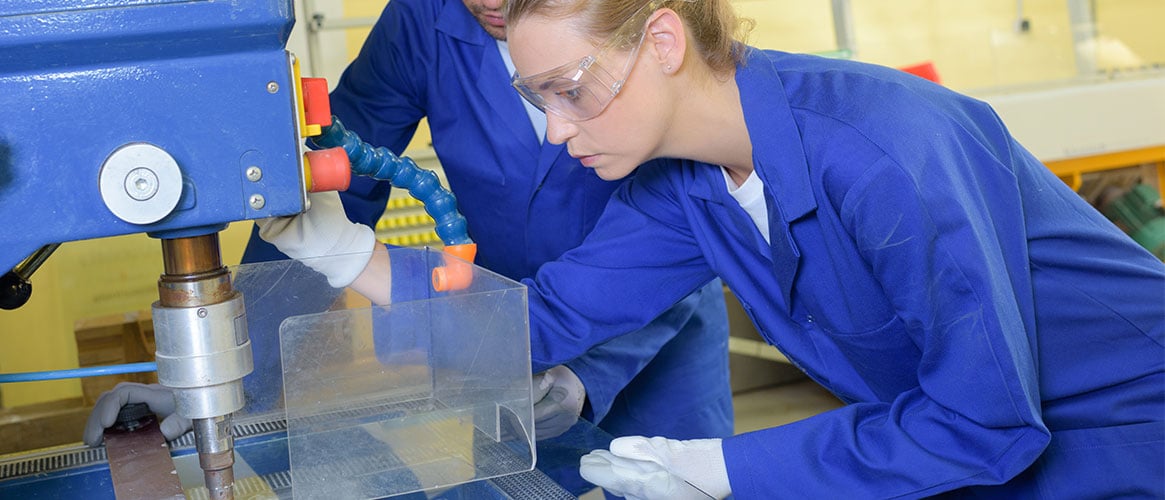In 2018, 58 percent of the non-fatal work-related amputations in the US involved some type of machinery like a power press. The impact force of a power press that punches, shears, or forms metal can also strike, crush, or sever a body part. To prevent power press injuries, it is important that your employees understand and use proper safeguarding, follow inspection and maintenance procedures, and receive effective employee training.
What your employees need to know about preventing power press injuries
The point of operations is the most dangerous part of the power press. It’s the area on a machine where work is performed on the material being processed.
Safeguarding
A safeguard is a device or system that protects any part of an employee’s body from coming in contact with the point of operations. Safeguard devices or systems may not be removed, tampered with, or bypassed.
Cal/OSHA regulations require all control buttons and switches for power-operated presses to be color coded and identified by function and purpose. They also must be designed to prevent premature or accidental tripping during operation or maintenance.
Inspection and maintenance
Equipment must be inspected and maintained to keep it working safely. When cleaning, repairing, servicing, setting-up, or adjusting power presses, employees must follow proper de-energizing, isolating, and lockout/tagout procedures. These protect against electrocution and keep the machinery from starting up unexpectedly. Only employees with the proper training may perform maintenance on a power press.
Training
Untrained operators using complicated and dangerous machinery are a threat to themselves and their coworkers. An effective training program is a vital step to prevent power press injuries. Training from a competent person or qualified trainer is required before anyone operates a power press.
Training should be specific for each machine and include:
- How to inspect the machine
- Safe work procedures
- Manufacturers’ instructions
- Identification of the hazards of each machine
- Where the moving/rotating/cutting parts are located
- How safeguarding devices or systems prevent workers from getting injured
- Reminders to never remove, bypass, or circumvent the safeguarding devices or systems in any way
- How to operate the machine
- How to shut the machine down
- Lockout/tagout procedures
What your employees need to do to avoid power press injuries
Check the power press at the beginning of each shift, following each new die setup, and when operators change. Make sure all parts, auxiliary equipment, and safeguards are in place, properly adjusted, and in safe operating condition.
At least once per week, conduct a functional performance check to ensure components are operating safely and complete all necessary maintenance or repairs before the press is returned to operations.
Before being cleared to use a power press, you must demonstrate:
- How to use all power press controls and safeguarding devices
- How to use any auxiliary components, such as tools to remove “stuck work” or lubricating swabs, brushes or oil cans
- Where to store parts, tools, or other materials so that they do not create hazards
- How to complete any required checks or inspections prior to production operations
It’s important to be fully attentive to the machine, concentrate on the job, and avoid distractions. Demonstrate to your employees how to identify when a press isn’t functioning properly. Listen to the machine and if the sound it makes changes, that could be an indication something is wrong.
And, use the proper personal protective equipment (PPE). Safety goggles, gloves, and hearing protection are all necessary to help protect against injuries from the work material, excess noise, and flying particles.
What to cover at your safety meeting on preventing power press injuries
Discuss and demonstrate how safeguarding devices or systems work. Make sure all employees who use or interact with the power press are part of this discussion.
Other steps to cover include:
- Reminding employees to immediately stop work and notify a supervisor if safeguarding devices or systems don't work or are not in place
- Reviewing the requirements for who is authorized to operate, inspect, or service machinery
- Providing regular refresher training to all employees, regardless of their level of training—this includes a review all operations, inspections, service, and maintenance procedures.
- Reviewing accidents and near misses with employees. Solicit feedback for improving processes, operations, or safeguarding devices or systems.
Severe crushing injuries, amputations, or death can be prevented with proper safeguarding, proper inspection and maintenance procedures, and effective employee training. Talk to your employees today about using the power press safely.

